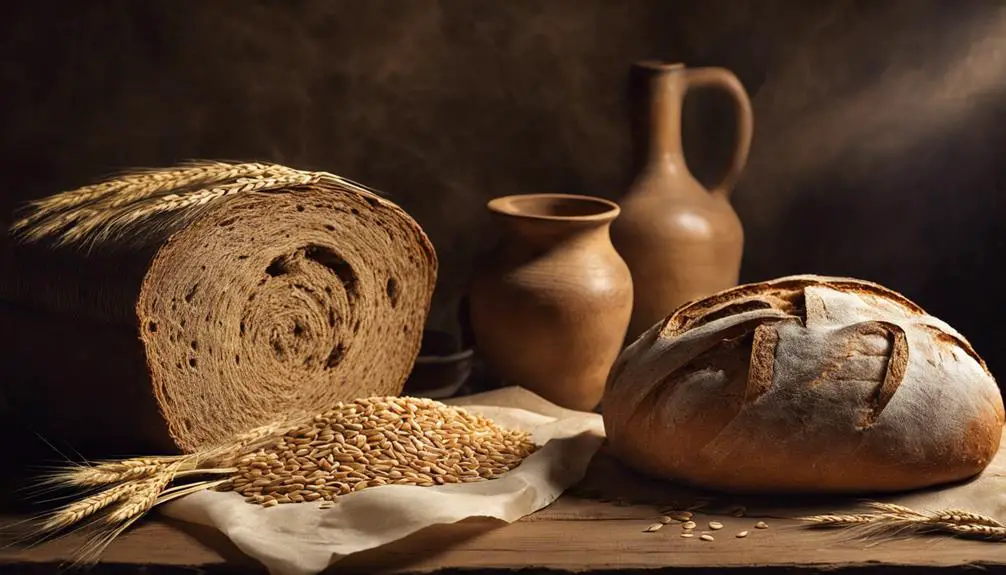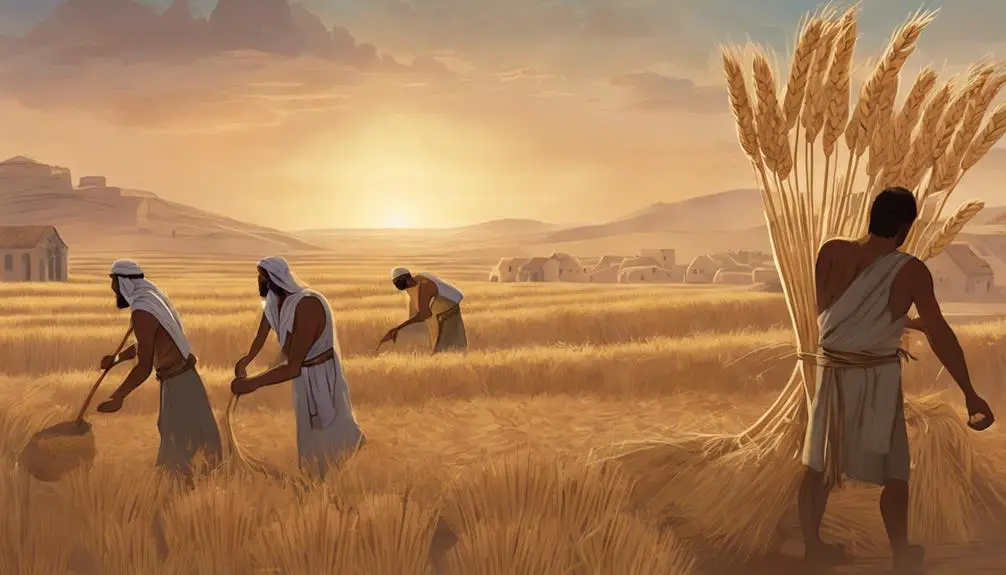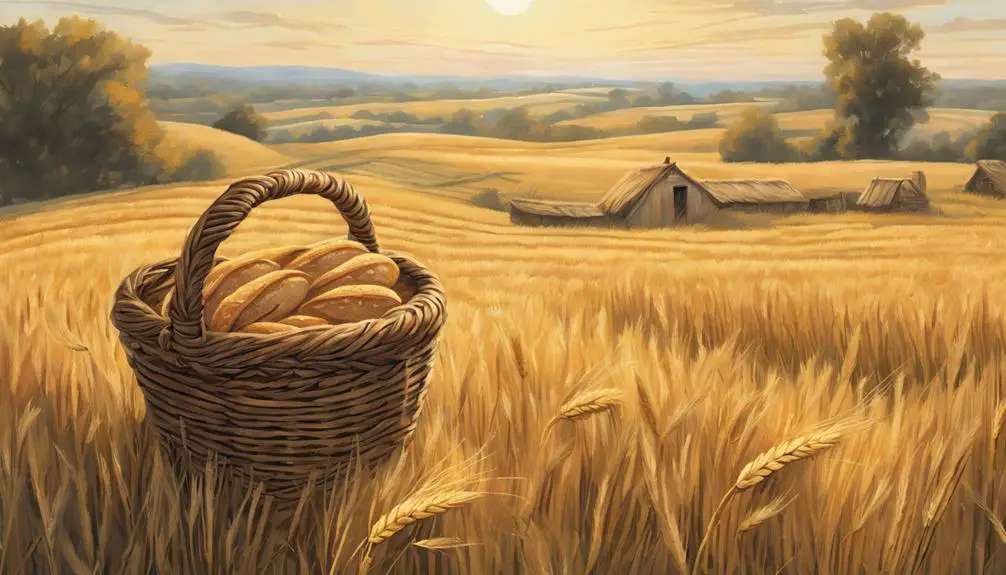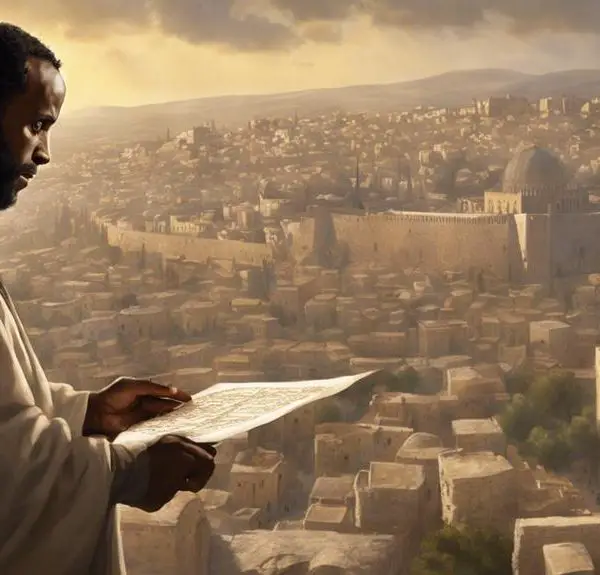A symbol of humility and divine provision, the barley loaf in the Bible carries profound meanings waiting to be uncovered. Discover its significance…

Barley Loaf in the Bible
You might think that a barley loaf is just a mundane detail in the grand tapestry of Biblical narratives, yet it holds layers of significance that are both profound and enlightening. Consider how barley, often seen as the bread of the poor, weaves its way through stories of miraculous provision and symbolic revelations.
From Gideon's victory to the feeding of the 5,000, this humble grain embodies themes of humility, hope, and divine sustenance. Unpacking its symbolism opens up a rich dialogue on faith, miracles, and the everyday grace found in the least expected places.
Let's explore what this could mean for our understanding of Biblical messages and their relevance today.
Key Takeaways
- Barley loaves symbolize divine provision and sustenance in biblical narratives.
- In Gideon's victory, a barley loaf represents divine intervention and favor.
- The Feeding of the 5,000 showcases barley loaves as symbols of divine abundance and care.
- Barley's symbolism in the Bible emphasizes humility, hope, and the importance of faith.
Historical Context of Barley

Barley, one of the earliest cultivated grains, has played a pivotal role in human civilization, offering insights into the agricultural practices and societal structures of ancient communities. Its cultivation, deeply rooted in the fertile crescent, showcases the ingenuity and adaptability of early farmers. You'll find that barley's resilience to harsh conditions made it a staple, shaping the agricultural practices of those times. This grain's versatility not only nourished populations but also fostered the development of trade routes, connecting distant civilizations.
The emergence of these trade routes can be attributed to barley's storability and transportability, characteristics that made it an ideal commodity for long-distance trade. You're looking at a scenario where barley served as a catalyst for economic and cultural exchanges across regions. These interactions, facilitated by the movement of barley along trade routes, introduced innovations in agricultural practices, including irrigation techniques and crop rotation, that were instrumental in sustaining civilizations.
Analyzing barley's historical context, you'll understand its significance goes beyond mere sustenance. It represents a linchpin in the evolution of agricultural practices and the establishment of trade routes that shaped the ancient world, influencing the socioeconomic and cultural landscapes of diverse societies.
Symbolism in Biblical Stories
Delving into biblical narratives, you'll uncover that various stories are woven with symbolism, where everyday elements like barley loaves play significant roles in conveying deeper spiritual and moral messages. This analysis highlights how these symbols, notably barley loaves, are not merely incidental but are imbued with profound significance.
Symbol |
Interpretation |
|---|---|
Barley Loaf |
Represents sustenance and the provision of God, often in times of scarcity. |
Animal Metaphors |
Serve as embodiments of virtues or vices, illustrating moral lessons. |
Sacrificial Rituals |
Symbolize purification, redemption, and the covenant between divinity and humanity. |
Water |
Often signifies cleansing and renewal, pivotal in spiritual transformations. |
In the realm of biblical literature, animal metaphors and sacrificial rituals are recurrent themes that enrich the narrative landscape. These elements don't just decorate the text; they convey layers of meaning, reflecting the values, struggles, and aspirations of the communities that cherished these stories. Through an analytical lens, you'll appreciate how these symbols function as vehicles for theological discourse, moral instruction, and communal identity within the biblical canon. Their inclusion underscores the interconnectedness of the material and spiritual, the individual and the collective, in the pursuit of divine truth and human understanding.
Miraculous Provision of Barley

Building on the symbolic significance of barley loaves, let's explore their role in narratives of miraculous provision, where they underscore divine generosity and care in times of need. These stories not only highlight the importance of barley as a staple food but also illustrate the intertwining of divine intervention with agricultural practices. Barley, being one of the earliest crops to be harvested, often symbolizes the beginning of the agricultural year and the hope it brings for future sustenance.
In the context of miraculous provision:
- The multiplication of barley loaves: This event showcases the ability to provide abundantly, surpassing the limitations of the natural barley harvest cycle.
- Divine intervention in agricultural practices: It emphasizes the belief that beyond human effort and knowledge in farming, a higher power plays a crucial role in the success of crops.
- Barley as a sign of hope and sustenance: These narratives underscore barley's role in sustaining communities through times of scarcity.
Barley Loaf in Gideon's Victory
In the narrative of Gideon's victory, a barley loaf assumes a pivotal role, symbolizing divine intervention and the overturning of seemingly insurmountable odds. This incident, deeply embedded in biblical lore, showcases how dream interpretation and military strategy intertwine, leading to an unexpected triumph.
You'll find that the barley loaf, considered a humble offering, becomes a metaphor for Gideon's army. Despite their small size and modest means, they're destined to conquer the Midianites, a formidable force.
The dream, recounted by a Midianite soldier, depicts a barley loaf tumbling into the Midianite camp, striking a tent with such force that it collapses. This dream interpretation, divinely guided, emboldens Gideon and his men. It's a clear indication that, despite their numerical disadvantage, they've divine favor. This insight plays a critical role in their military strategy, encouraging unconventional tactics.
Gideon's army, armed with the knowledge that their victory is assured by higher powers, adopts a strategy that relies more on psychological warfare than brute force. This episode highlights the importance of faith and strategic thinking in overcoming obstacles, making the barley loaf a symbol of divine providence and ingenious military planning.
The Feeding of the 5,000

Similarly, the miraculous tale of the Feeding of the 5,000 demonstrates the profound impact of simple provisions, like barley loaves, in manifesting divine abundance and care. This narrative not only highlights the miraculous multiplication of food but also underscores the importance of crowd management and the symbolic significance of basket leftovers. Through a scholarly lens, let's delve deeper into the nuances of this event:
- Crowd Management: The orderly distribution of food to such a large gathering underscores a meticulous approach to crowd management. It showcases an organized method that ensured everyone was fed without chaos, a testament to the importance of structure even in the midst of a miracle.
- Basket Leftovers: The collection of twelve baskets of leftovers after feeding the multitude symbolizes abundance beyond need. This aspect of the story emphasizes the idea that divine provision not only meets but exceeds our necessities.
- Symbolic Significance: The barley loaves, often considered food of the poor, highlight a theme of humility and inclusivity. This miracle indicates that divine care extends to all, regardless of social standing.
Analyzing the Feeding of the 5,000 through these lenses offers a deeper understanding of its significance, blending the miraculous with practical lessons in leadership and compassion.
Frequently Asked Questions
How Did the Preparation and Consumption of Barley Bread Differ Among Various Classes in Ancient Societies, Especially in Biblical Times?
In ancient societies, your social class greatly influenced how you prepared and consumed barley bread. The wealthy might afford diverse cooking methods, enhancing flavor and texture. Meanwhile, the poor, heavily impacted by grain taxation, often settled for simpler, less refined bread.
This class divide not only affected bread's quality but also its symbolic significance in communal rituals and daily sustenance, reflecting broader societal structures and inequalities in access to resources.
Are There Specific Dietary or Health Benefits Attributed to Barley in Ancient Texts or by Early Biblical Scholars That Are Acknowledged Today?
You're exploring whether ancient texts or early biblical scholars recognized specific dietary or health benefits of barley that are still acknowledged today. Indeed, ancient remedies and writings highlighted barley's nutrition, emphasizing its role in promoting health and treating ailments.
This grain was praised for its versatility and nutritional value, aspects that modern research supports, especially in terms of fiber content and heart health benefits. Thus, historical perceptions of barley's benefits have persisted into contemporary understanding.
How Has the Cultivation and Use of Barley Evolved From Biblical Times to the Present Day in the Regions Mentioned in the Bible?
Barley's journey from ancient cultivation to modern times has seen significant evolution. Interestingly, 30% of barley's genetic diversity reflects adaptations to diverse climates, including those in regions mentioned historically. This genetic resilience has allowed barley to withstand climate impacts, ensuring its staple status over millennia.
Advances in barley genetics have further optimized its use in food, beverage, and animal feed, showcasing a remarkable evolution from its earliest documented uses to today's global agricultural landscape.
In What Ways Did Barley Loaf Feature in Religious Rituals or Ceremonies Outside of the Well-Known Biblical Stories?
Barley loaf's significance extends beyond biblical narratives, embodying deep-rooted symbolism across various cultures. In your exploration, you'll discover that barley's symbolism and its role in ritual diversity highlight its importance in ceremonies outside well-known stories.
This grain has been a symbol of fertility, abundance, and sacrifice, playing pivotal roles in religious rituals. Its adaptability and resilience have made it a staple in ceremonial practices, reflecting the community's values and beliefs.
Can the Significance of Barley in the Bible Be Linked to Any Modern-Day Religious Practices or Symbolism Within Contemporary Christian Communities?
You might wonder if barley symbolism from ancient texts influences modern religious practices. Indeed, in contemporary Christian communities, barley's significance echoes through modern feasts and observances, though subtly.
It serves as a symbol of sustenance, humility, and renewal, reflecting its biblical roots. This connection enriches the spiritual fabric, linking past traditions with present faith expressions, and inviting a deeper understanding of shared religious symbols across time.
Conclusion
In the tapestry of biblical narratives, the humble barley loaf emerges as a symbol of both providence and prophecy. While Gideon's victory underscores God's ability to use the seemingly insignificant for monumental purposes, the feeding of the 5,000 demonstrates Christ's capacity for miraculous provision.
This juxtaposition not only reveals the multifaceted symbolism of barley but also underscores a deeper theological truth: divine power often manifests through the ordinary, inviting believers to find the sacred in the simplicity of daily sustenance.



Sign up